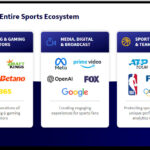Sportradar sees gains in revenue, cash flow
Revenues for Sportradar grew 14.5% in the third quarter, reaching €292.1 million (US$336 million)1 EUR = 1.1496 USD
2025-11-05Powered by CMG CurrenShift, in results released on 5 November.
Thanks to what Chief Financial Officer Craig Felenstein characterized as “predictable and sustainable sports-rights costs,” cash flow was €85 million (US$98 million)1 EUR = 1.1496 USD
2025-11-05Powered by CMG CurrenShift. Sports-rights expenses escalated 15% because of renewals of ATP and MLB contracts.
Sportradar realized a €22.5 million (US$25.9 million)1 EUR = 1.1496 USD
2025-11-05Powered by CMG CurrenShift profit. It finished the third quarter with €360 million (US$414 million)1 EUR = 1.1496 USD
2025-11-05Powered by CMG CurrenShift in cash and no debt. Year to date, Sportradar has repurchased US$386 million worth of SRAD shares, at US$17.96 apiece. Felenstein stressed that reinvestment in the company was Sportradar’s priority for its cash. However, the company allocated an additional US$100 million to share repurchases.
Jefferies Equity Research analyst David Katz opined that the third-quarter results “should net to neutral for the shares.” He noted that Sportradar had come in under his projection of €296 million (US$340 million)1 EUR = 1.1496 USD
2025-11-05Powered by CMG CurrenShift, but its full-year predictions were “implying strong margin improvement.”
Sportradar cash flow of €85 million (US$98 million)1 EUR = 1.1496 USD
2025-11-05Powered by CMG CurrenShift well exceeded Katz’s projection of €78 million (US$90 million)1 EUR = 1.1496 USD
2025-11-05Powered by CMG CurrenShift.
Growth was greatest in the US, where revenues shot up 30%. They were 11% higher in the rest of the globe. US business, however, represented 23% of Sportradar’s total picture.
For J.P. Morgan analyst Samuel Nielsen, that “modest revenue miss [was] more than offset by lower costs, reflecting operating leverage.” He added that Sportradar’s increased full-year guidance implied a 20% revenue increase.
Sportradar began its earnings call Wednesday with the announcement that it was authorizing an additional US$100 million in share repurchases. SRAD shares were trading at US$25.58 at the time.
David McKee is an award-winning journalist who has three decades of experience covering the gaming industry.
Verticals:
Sectors:
Topics:
Dig Deeper
The Backstory
Setting the stage for Sportradar’s quarter
Sportradar’s latest results land in a sector where operators are tightening execution, leaning into product and pushing for cash generation. That backdrop helps explain why a data supplier’s revenue growth and cash flow trajectory resonate beyond one quarter. In recent months, several major operators have reported stronger earnings power and sharpened guidance, with product upgrades and marketing efficiency doing much of the work. Those trends funnel into demand for data integrity, live odds and automation — areas where suppliers monetize volume and reliability. They also raise the bar on cost discipline, which matters as rights renewals and league partnerships reprice.
The U.S. remains the proving ground. Operators there are pressing for conversion, hold improvement and responsible marketing spend, which puts pressure on data providers to deliver latency, coverage and tools that lift lifetime value without bloating costs. Internationally, currency volatility and mixed user growth complicate forecasting but still favor partners that can localize content and pricing. Against that industry math, Sportradar’s mix of U.S. growth, global exposure and rights renewal cadence becomes central to how investors handicap its margins across the next four quarters.
Operators pivot from growth at all costs to profitable scale
One clear signal came from BetMGM. In late July, the joint venture between Entain and MGM Resorts posted a 36% jump in second-quarter net revenue and a swing in cash flow from US$8 million to US$86 million, crediting better player targeting and a stronger product set. The company also lifted full-year revenue guidance to US$2.7 billion and boosted its cash-flow outlook to US$150 million. That update underscored a sector-wide pivot, where growth is increasingly expected to self-fund rather than rely on parent balance sheets. Read the details from BetMGM’s second-quarter results.
BetMGM then doubled down ahead of its third-quarter call, raising full-year revenue guidance to nearly US$2.8 billion and cash flow to about US$200 million, while signaling a US$200 million dividend to its co-owners by year-end. Management cited improved marketing efficiency, stronger brand positioning and measurable platform gains in both online sports and igaming. The move — to guide higher and commit to return of capital in the same breath — amplified the market’s focus on sustainable margins. For more, see how the operator raised full-year projections and planned a dividend.
That operating stance has consequences up the value chain. When sportsbooks prioritize margin and retention, they tend to demand more differentiated pricing, richer in-play markets and dependable feeds that reduce trading risk. Suppliers with scale and predictable rights costs can price for volume and service-level consistency, which in turn supports operator guidance. The inverse also applies: rights inflation, latency issues or uneven product delivery can ripple into operator hold and bonus spend.
Cash discipline travels across markets
The discipline narrative isn’t confined to the U.S. Codere Online cut its second-quarter loss year over year and expanded operating cash flow despite a 1% revenue dip tied to Mexican peso devaluation. Mexico remained its growth engine, with monthly active users up 36%, while Spain softened and the rest of Latin America contracted. The operator reaffirmed full-year revenue and cash-flow guidance and continued modest buybacks. The company’s results — navigating FX headwinds while protecting profitability — reflect how regional operators are prioritizing durable cash conversion over sheer top-line expansion. See how Codere Online narrowed losses and improved cash flow.
For data partners, that posture rewards offerings that can be tuned market by market. Mexico’s momentum demands deep local leagues, mobile-first UX and risk controls that accommodate volatile currency environments. Spain’s competitive dynamics require sharper segmentation and cross-sell to protect share. Where operators push for predictable returns, suppliers with granular data coverage and modular services have an edge in wallet share and contract longevity.
Ownership changes reset procurement and strategy
The ownership battle around PointsBet adds another layer to the sector’s evolution. Mixi, the Japanese entertainment group, crossed the 50% threshold in September via its Australian unit, extending the takeover timetable and weakening a rival bid from Betr. With majority control, Mixi has greater latitude to set PointsBet’s strategic priorities, board representation and capital allocation. That could influence vendor selection, tech stack decisions and international growth lanes where data and trading services are critical inputs. Read how Mixi gained majority control of PointsBet.
By Sept. 5, Mixi Australia held 51.86% of PointsBet shares, confirmed its AU$1.25 per-share cash offer and signaled it would not collaborate with Betr. That clarification reduced uncertainty around governance and future transaction complexity. If a tighter, single-owner strategy follows, PointsBet’s procurement could skew toward fewer, deeper vendor relationships and faster product roadmap decisions — dynamics that typically favor scaled suppliers. For the timeline and terms, see Mixi Australia’s majority milestone and offer details.
Consolidation also tends to compress the buyer set. Larger operators with clearer mandates can negotiate volume-based pricing and demand integrations that reduce operational overhead. For suppliers, that can mean lower per-unit pricing but more stable, multi-territory contracts with higher utilization — a trade-off that benefits firms with the capacity to deliver consistently across leagues and time zones.
Rights inflation, guidance and the next innings
The common thread through these developments is predictability. Operators lifting guidance and returning cash are betting their product and marketing engines will hold, and that supplier ecosystems will support that trajectory. For a data company, predictability often lives in two places: the cost and term structure of sports-rights deals, and the resilience of demand from operators growing into profitability.
Rights renewals with blue-chip leagues can push expenses higher in the near term but also secure the assets that underpin in-play growth. When those costs are contracted on terms that management can forecast, suppliers can manage margin and invest in product without whipsawing cash generation. That is especially important as the U.S. contributes a larger share of sector growth and as international markets cycle through currency and regulatory swings.
The operator prints from BetMGM and Codere Online point to a customer base that is more selective, more focused on return and more willing to direct spend toward capabilities that move hold and retention. The ownership reset at PointsBet signals procurement decisions could concentrate further, with strategic owners preferring partners that scale with their ambitions. In that environment, a supplier’s ability to translate rights stability into steady cash flow — while supporting operators’ push for margin — becomes a competitive advantage.
The stakes are straightforward. If operator demand for faster, deeper in-play persists and rights costs remain manageable, leading data providers can convert volume into cash and sustain buybacks or reinvestment without stretching the balance sheet. If rights inflation outruns revenue or if operator growth cools, margin targets will be harder to defend. The recent cadence of raised guidance, stronger cash generation and consolidation suggests the industry is leaning toward the former — but it also raises expectations for consistent delivery from every link in the value chain.








